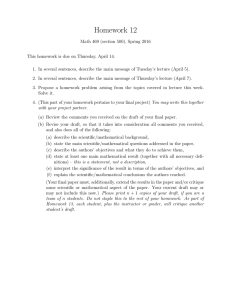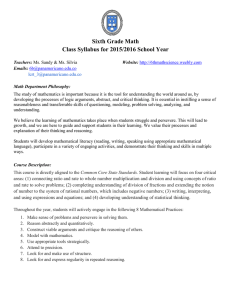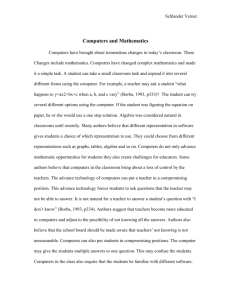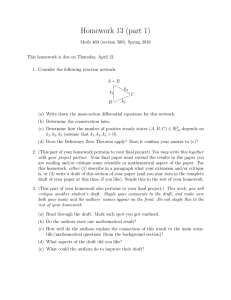Martin Hughes, Charles Desforges, and Christine developing process skills (decision making, Mitchell
advertisement
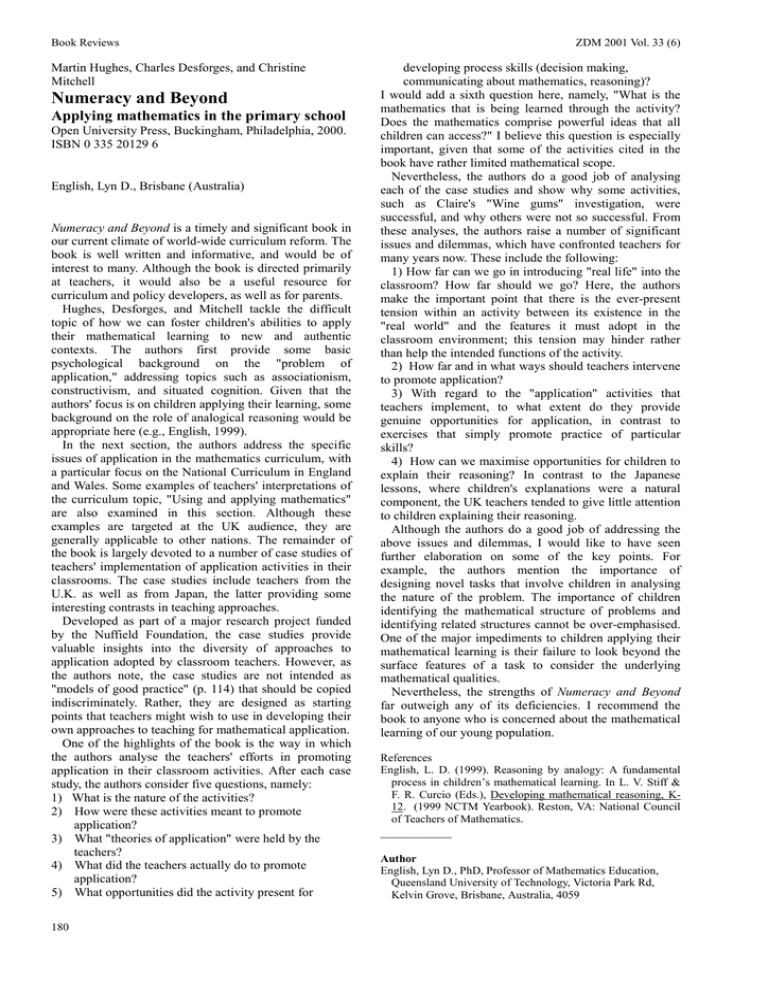
Book Reviews Martin Hughes, Charles Desforges, and Christine Mitchell Numeracy and Beyond Applying mathematics in the primary school Open University Press, Buckingham, Philadelphia, 2000. ISBN 0 335 20129 6 English, Lyn D., Brisbane (Australia) Numeracy and Beyond is a timely and significant book in our current climate of world-wide curriculum reform. The book is well written and informative, and would be of interest to many. Although the book is directed primarily at teachers, it would also be a useful resource for curriculum and policy developers, as well as for parents. Hughes, Desforges, and Mitchell tackle the difficult topic of how we can foster children's abilities to apply their mathematical learning to new and authentic contexts. The authors first provide some basic psychological background on the "problem of application," addressing topics such as associationism, constructivism, and situated cognition. Given that the authors' focus is on children applying their learning, some background on the role of analogical reasoning would be appropriate here (e.g., English, 1999). In the next section, the authors address the specific issues of application in the mathematics curriculum, with a particular focus on the National Curriculum in England and Wales. Some examples of teachers' interpretations of the curriculum topic, "Using and applying mathematics" are also examined in this section. Although these examples are targeted at the UK audience, they are generally applicable to other nations. The remainder of the book is largely devoted to a number of case studies of teachers' implementation of application activities in their classrooms. The case studies include teachers from the U.K. as well as from Japan, the latter providing some interesting contrasts in teaching approaches. Developed as part of a major research project funded by the Nuffield Foundation, the case studies provide valuable insights into the diversity of approaches to application adopted by classroom teachers. However, as the authors note, the case studies are not intended as "models of good practice" (p. 114) that should be copied indiscriminately. Rather, they are designed as starting points that teachers might wish to use in developing their own approaches to teaching for mathematical application. One of the highlights of the book is the way in which the authors analyse the teachers' efforts in promoting application in their classroom activities. After each case study, the authors consider five questions, namely: 1) What is the nature of the activities? 2) How were these activities meant to promote application? 3) What "theories of application" were held by the teachers? 4) What did the teachers actually do to promote application? 5) What opportunities did the activity present for 180 ZDM 2001 Vol. 33 (6) developing process skills (decision making, communicating about mathematics, reasoning)? I would add a sixth question here, namely, "What is the mathematics that is being learned through the activity? Does the mathematics comprise powerful ideas that all children can access?" I believe this question is especially important, given that some of the activities cited in the book have rather limited mathematical scope. Nevertheless, the authors do a good job of analysing each of the case studies and show why some activities, such as Claire's "Wine gums" investigation, were successful, and why others were not so successful. From these analyses, the authors raise a number of significant issues and dilemmas, which have confronted teachers for many years now. These include the following: 1) How far can we go in introducing "real life" into the classroom? How far should we go? Here, the authors make the important point that there is the ever-present tension within an activity between its existence in the "real world" and the features it must adopt in the classroom environment; this tension may hinder rather than help the intended functions of the activity. 2) How far and in what ways should teachers intervene to promote application? 3) With regard to the "application" activities that teachers implement, to what extent do they provide genuine opportunities for application, in contrast to exercises that simply promote practice of particular skills? 4) How can we maximise opportunities for children to explain their reasoning? In contrast to the Japanese lessons, where children's explanations were a natural component, the UK teachers tended to give little attention to children explaining their reasoning. Although the authors do a good job of addressing the above issues and dilemmas, I would like to have seen further elaboration on some of the key points. For example, the authors mention the importance of designing novel tasks that involve children in analysing the nature of the problem. The importance of children identifying the mathematical structure of problems and identifying related structures cannot be over-emphasised. One of the major impediments to children applying their mathematical learning is their failure to look beyond the surface features of a task to consider the underlying mathematical qualities. Nevertheless, the strengths of Numeracy and Beyond far outweigh any of its deficiencies. I recommend the book to anyone who is concerned about the mathematical learning of our young population. References English, L. D. (1999). Reasoning by analogy: A fundamental process in children’s mathematical learning. In L. V. Stiff & F. R. Curcio (Eds.), Developing mathematical reasoning, K12. (1999 NCTM Yearbook). Reston, VA: National Council of Teachers of Mathematics. ___________ Author English, Lyn D., PhD, Professor of Mathematics Education, Queensland University of Technology, Victoria Park Rd, Kelvin Grove, Brisbane, Australia, 4059 ZDM 2001 Vol. 33 (6) Book Reviews Tel: 617 3864 3329 Fax: 617 3864 3985 E-mail: l.english@qut.edu.au 181

